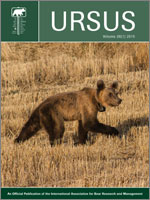Both black (Ursus americanus) and grizzly bears (U. arctos) are known to rub on trees and other objects, producing a network of repeatedly used and identifiable rub sites. In 2012, we used a resource selection function to evaluate hypothesized relationships between locations of 887 bear rubs in northwestern Montana, USA, and elevation, slope angle, density of open roads and distance from areas of heightened plant-productivity likely containing forage for bears. Slope and density of open roads were negatively correlated with rub presence. No other covariates were supported as explanatory variables. We also hypothesized that bear rubs would be more strongly associated with closed roads and developed trails than with game trails. The frequencies of bear rubs on 30 paired segments of developed tracks and game trails were not different. Our results suggest bear rubs may be associated with bear travel routes, and support their use as “random” sampling devices for non-invasive spatial capture–recapture population monitoring.
How to translate text using browser tools
1 May 2015
Modeling multi-scale resource selection for bear rubs in northwestern Montana
Matthew J. Morgan Henderson,
Mark Hebblewhite,
Michael S. Mitchell,
Jeff B. Stetz,
Katherine C. Kendall,
Ross T. Carlson
ACCESS THE FULL ARTICLE

Ursus
Vol. 26 • No. 1
May 2015
Vol. 26 • No. 1
May 2015
bear rub
non-invasive genetic sampling
resource selection function
Ursus americanus
Ursus arctos




